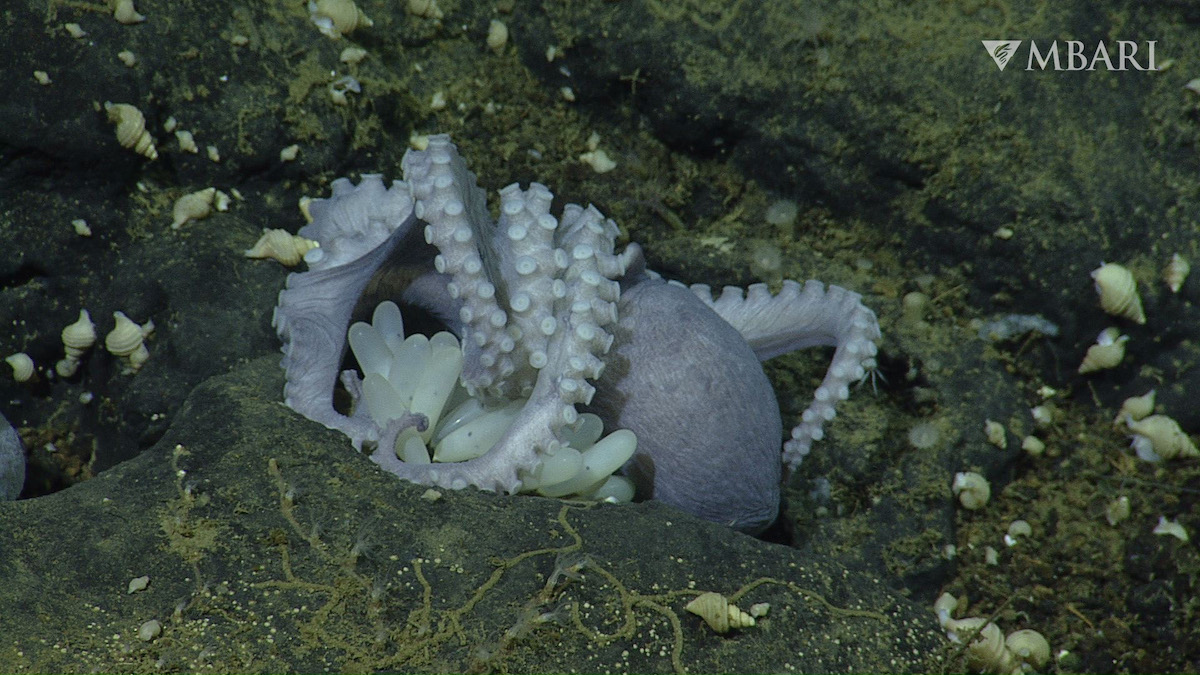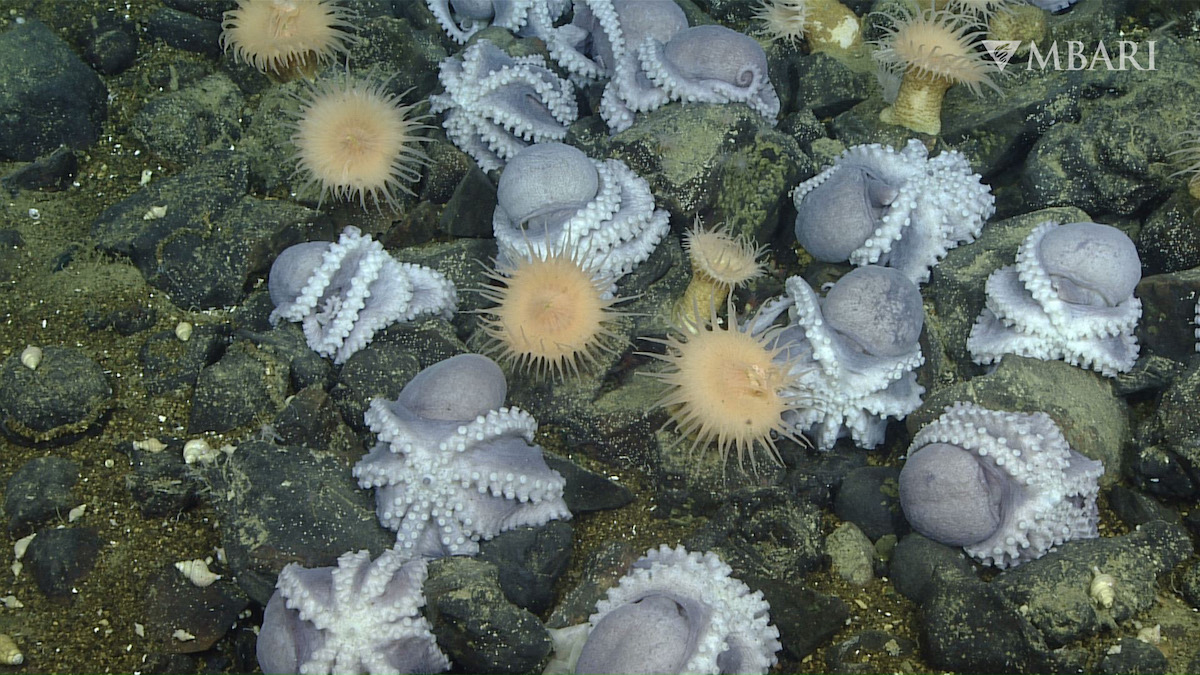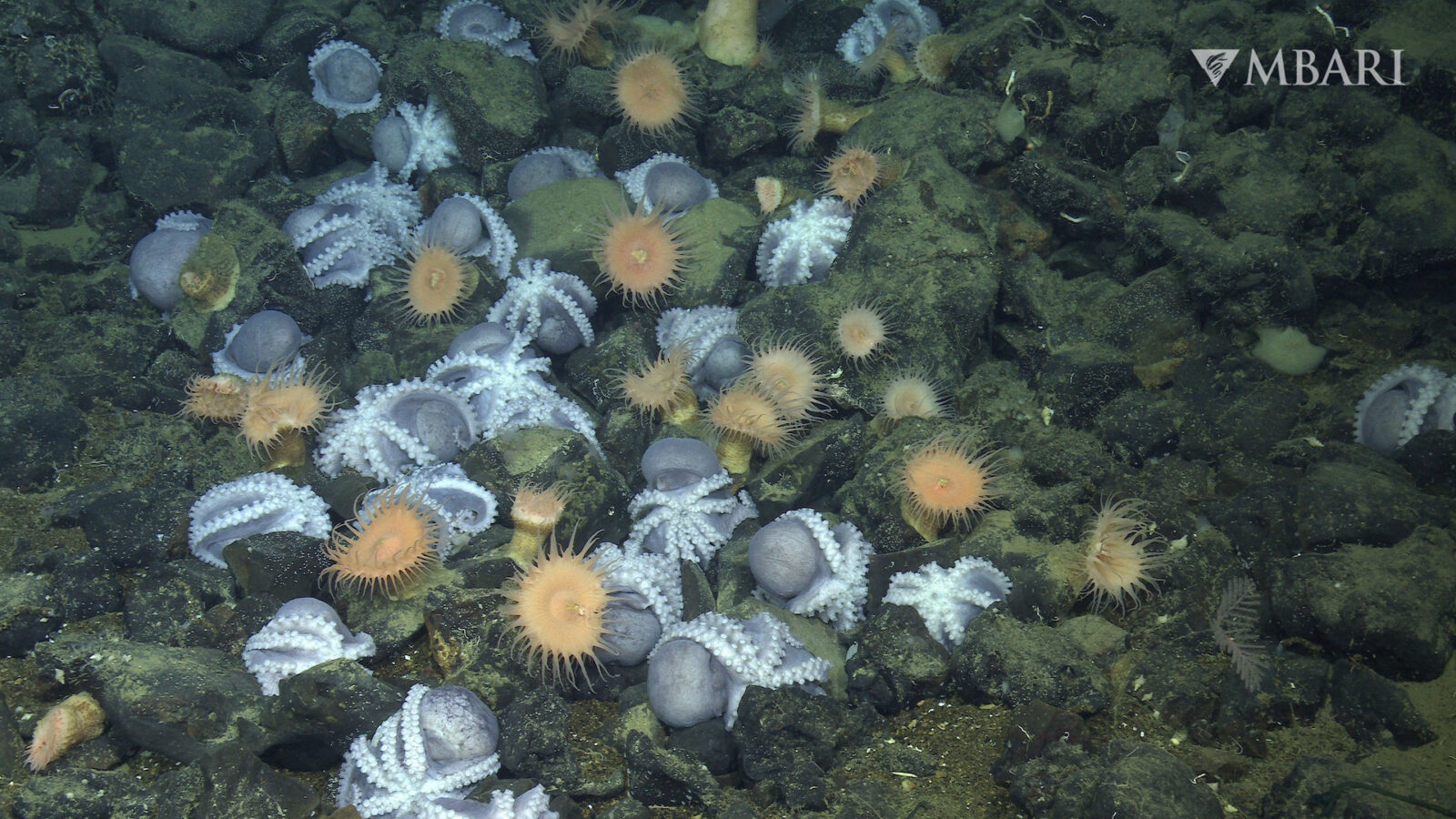Nearly two miles below the ocean’s surface, off the coast of Central California, in the darkness known as the “midnight zone,” an octopus mom-to-be lands on the lava-textured foothills of the Davidson Seamount, looking for a spot to nest. She crawls past the pushy tentacles of nearby nesters, and reaches her prize: a nook of warmth in the otherwise bitterly cold sea. She tidies the ground of stray schmutz, any lingering egg-eaters, and the vacant shells of the last nest in this spot, and begins laying her clutch of eggs—amidst perhaps 20,000 others just like her. This is the largest known aggregation of octopuses in the world, and now scientists studying it have answered the question of why they are here: the hydrothermal springs around the seamount offer the octopuses an evolutionary edge.
In a paper published on Wednesday in Science Advances, researchers led by the Monterey Bay Aquarium Research Institute described how the warm waters accelerate the growth of baby octopuses, cutting down the mother’s brooding period from an estimated five to eight years to just 1.8.

Andrew DeVogelaere, a scientist who oversees the Monterey Bay Marine Sanctuary’s research program, called the “octopus garden” a “hotbed of an area that seems to be really important—not only for this species, but in terms of providing food and life for the whole region.” And for scientists, it is a rare find—one that offers a case study in how thermal springs can affect deep-sea biological communities.
Scientists from NOAA’s Monterey Bay National Marine Sanctuary and the nonprofit Ocean Exploration Trust first discovered this octopus garden by chance, on a 2018 dive with a remotely operated vehicle. The team decided to take a break from watching the coral communities atop the Davidson Seamount and look at deeper waters toward the sides of the extinct volcano. There, DeVogelaere says, they saw “thousands of white pearls.” All were Muusoctopus robustus, a pale purple-white, grapefruit-sized deep-sea octopus first described scientifically in 1990. “It was exciting to us because this is the first time human eyes have ever seen this part of the planet,” DeVogelaere says.

MBARI scientists, alongside researchers from NOAA’s Monterey Bay National Marine Sanctuary, Moss Landing Marine Laboratories, the University of Alaska Fairbanks, the University of New Hampshire, and the Field Museum, returned to study the nursery, which lies within the sanctuary. Over the course of three years, a research team conducted 12 research cruises, and 14 dives made by an ROV specifically designed to observe benthic communities—Doc Ricketts.
Of the thousands of mothers gently probed by Doc Ricketts’ robotic arms, not a single one was nesting in cold water. This has led scientists like DeVogelaere to wonder if these octopuses have been gaming the system long before humans knew what they were doing—or if they’ve ever nested in cold waters at all.
“We have a lot of seamounts in the oceans, over 10,000 of them,” DeVogelaere says. “I wonder if we looked at the sides of all of the seamounts, and did a real good mapping of Davidson, if we would find that these [gardens] maybe aren’t that rare.”
Where warmer is better
Octopuses are semelparous: they only reproduce once, dying after their eggs hatch, and therefore can’t afford to make mistakes.
In the deep-sea garden, once a mother’s eggs—long, white-translucent sacs about one and a half inches long—are set on the surface, the nest can’t move. And soon after, neither can she. She flips onto her back, wrapping her tentacles around her body and her clutch, and enters a senescent state. She doesn’t eat, consumes energy from stored tissues, and moves only to swat at fish and other intruders, or possibly to aerate her eggs.
Some don’t make it the full two years. But, as DeVogelaere stresses, the warm waters in the seamount’s cracks are a mom’s best bet.
“If a female doesn’t have the energy to make 600 days, as we have seen in just one spot, then imagine if they have the energy to take care of their eggs without eating for four to five years,” DeVorelaere says. “It’s a big advantage.”
The rocks where it happens
Octopuses aren’t the only ones making the most of a scarce resource. Warm water has always been an attraction for the deep sea’s many cold-blooded creatures. Some rays, for example, are known to flock toward hydrothermal vents to nest.
But unlike hydrothermal vents, where water can burn as hot as 700 degrees Fahrenheit (371 degrees Celsius), the water around the seamount is a hydrothermal spring—ranging from 37 to 51 degrees (5 to 11 degrees Celsius), without changing much. For a mom with a stationary nest, the warmth makes a huge difference.
These octopuses “have a very plastic physiology,” Jim Barry, lead author of the study and senior scientist at MBARI, says. “They’re able to respond to temperature, just like all cold-blooded animals are.”

The heat comes from magma, miles beneath the seafloor, that heats up water above it. In a sediment-heavy seafloor like California’s, that water has nowhere to go.
“It’s like you took your home furnace system and you closed all the vents but one”—and that one vent is the Davidson Seamount, says David Clague, a senior adjunct geologist at MBARI who has studied the seamount since 2000. After pushing to and fro under the earth’s crust, the water finds the path of least resistance through cracks between the cooled lobes of lava that decorate the side of the seamount, and forms reliable sources of warm water.
It’s why the octopuses are cheek by jowl. Less than a meter from where the embryos are, the temperatures are closer to freezing, around just 35 degrees Fahrenheit (1.8 degrees Celsius).
Born into a hungry world
This garden is teeming with other life, too—including predators.
The mother’s long incubation assures that each baby octopus hatches with all that it needs to survive: a set of tentacles, and the impetus to run. The scientists’ videos show how, with jellyfish-like movements, the translucent younglings dart across a field of hungry predators.
Seeing these moments, DeVoreleare says, has sometimes challenged scientists’ neutrality toward their study subjects. “You’re watching this thing hatch, and then you’re seeing it sort of float away, and then you see a shrimp grab onto it,” he says. “And it’s kind of pulling in, there’s this tug of war, and then it gets away. And the scientists are like, ‘Yeah!’”
Where these little octopuses go, and how they find their way back to the garden, remains among the garden’s many mysteries. Little is known about the early years of Muusoctopus robustus. They have been seen at whale falls, eating the amphipods that were once their bullies.
For Danna Staaf, cephalopod expert and author of Nursery Earth, studying the dispersal of baby octopuses may reveal more about the connections between these different patches of vitality under the sea. “You can think about them as like islands or oases, really, but they’re also their own thing that can get colonized through dispersal,” Staaf says.
The (deep-sea) circle of life
Even if all goes well and the eggs hatch, the octopus mom will have used too much energy to live on for much longer. She is too tired to keep swatting at the fish, shrimp and anemones, and will soon succumb to death.
But it’s each Muusoctopus robustus for herself. In time-lapse footage captured by MBARI’s undersea cameras, a nearby nester is quick to push the carcass of another into the waiting jaws of an anemone, to make room for her own nest.

“Whoever eats the octopus, they’re going to miss some, cut it up, poop it out, or whatever,” Barry says. “And that organic carbon makes its way into everything from the anemones and the fish down to the microbes that live in the area.”
Not only the mother’s body. No scrap of biomass goes to waste in the deep sea. After a clutch hatches, Barry describes how its spot is cleared of lingering egg-sacs by hardworking snails, shrimp, and other scavengers.
Octopuses breed year-round, and so vacancies at the garden are usually occupied by a new mother within about 14 days. And so the cycle begins again, of life—and death—at the octopus garden.





